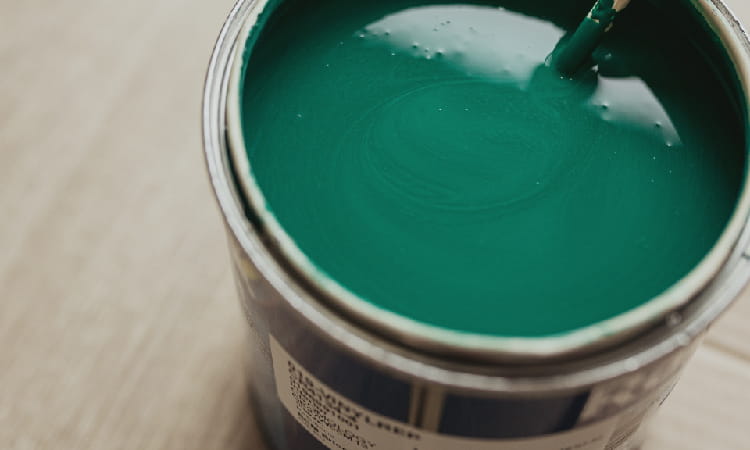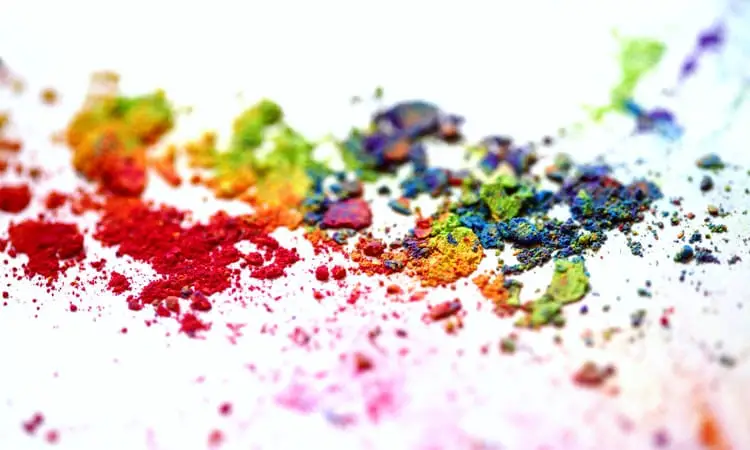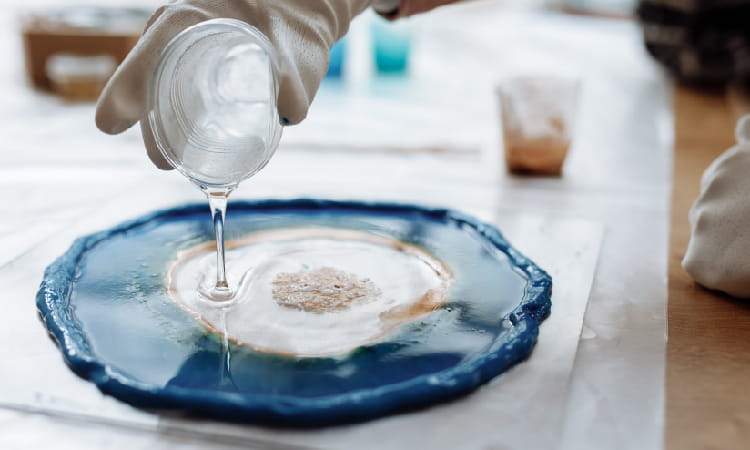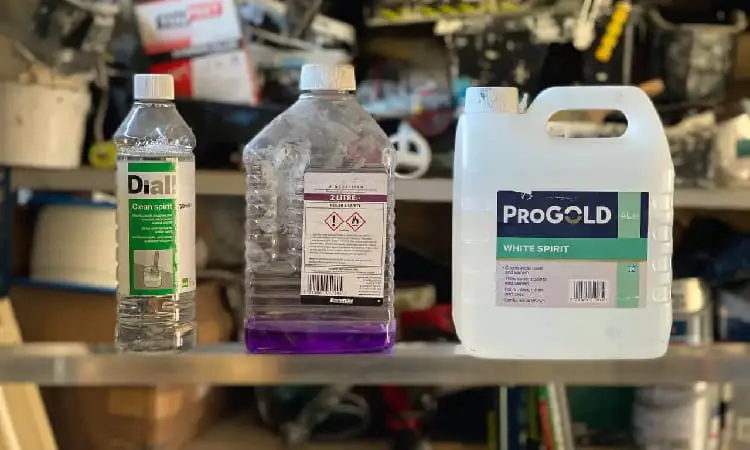It is always interesting to know how things are made and their components. Our inquisitive minds tend to learn things that interest us the most.
I can only suppose that you are interested in what paint is made of because you found this article.
Paint has four components: pigments, binders or resins, solvents, and additives. Each plays a specific role for the paint to stick on your walls, ceilings, and other surfaces. Pigments provide color, resins keep the color on the surface, solvents keep the paint liquid, and additives provide additional capabilities.
Read on to learn more about these different components and understand better how they contribute to making the paint functional.
You will also acquaint yourself with the manufacturing process and the critical steps and stages of paint-making.

Main Components of Paint
Paint is a complex composition of up to 12 ingredients, but three can be distinguished as the main components – pigments, binders, and solvents.
I will break down each of them in the sections below to help you understand what they are and what they do in paint.
What is Pigment and Why it is used in Paint?
Pigments are the almost insoluble particles dispersed into paint that provide color. Similar to dyes, they act as coloring agents of the paint or colorants.
The use of pigments as colorants dates back to pre-historic times when people used them to color their bodies or create art pieces.
The history of pigments reveals that the Chinese and Egyptians produce them on a larger scale during 3000 BC. The process involves washing earth colors to make them purer.
The first known red pigment comes from minerals such as malachite and azurite, while Egyptian blue comes from sand and copper.
As technology improves, the production of pigments becomes easier. Manufacturers have produced synthetic or inorganic products that provide more color options.
These pigments are derived from simple chemical reactions.
Types of Pigments
Pigments can be organic (based on carbon chains and rings) or inorganic (ground metals or salts).

1. Organic Pigments
Organic pigments are colored materials derived from organic compounds with organic properties, produced through synthesis.
The production process of these pigments is similar to that of organic dyes. There are 3 types of organic pigments.
First is Carbon Pigments, which are the carbon black from natural gas, the acetylene black from calcium carbide, and the lampblack from the soot of incomplete combustion of natural oils.
Then there are Lake Type Pigments, which are metal salt byproducts of anionic dyes.
The last type of organic pigment is the Non-Ionic Organic Pigments which refers to azoic dyes. These organic compounds are commonly used to color textiles.
Organic pigments are usually bright-colored and have excellent dispersion properties.
They are generally resistant to various elements such as sunshine, water, acids, alkali, solvents, and heat.
These pigments rely on paint binders for them to adhere to the surface. You can learn more about organic pigments here.
2. Inorganic Pigments
Compared to organic, inorganic pigments are not derived from carbon chains and rings. They come from dry ground minerals such as metals or metallic salts.
In terms of insolubility, these pigments are more insoluble compared to organic.
Inorganic pigments are produced through a chemical reaction, popularly known as oxidation. You can read this article to learn more about the techniques used in chemical manufacturing.
This video posted by Panos Egglezos on his Youtube channel might also provide more information.
Inorganic pigments are not as transparent as organic pigments. They also resist fading better than the latter.
In terms of price, they are more affordable, which could be the reason behind their popularity in the paint industry.
On the other hand, organic pigments do have some disadvantages. They have poor tonality compared to organic pigments.
They often look dull. Thus, paint companies usually mix organic and inorganic pigments to obtain better performance.
Combining both pigments helps manufacturers balance tonality and brightness.
Another notable drawback of inorganic pigments is their toxicity. The presence of lead salts can be dangerous to the environment, even humans.
You can check the complete comparison between organic and inorganic pigments here.
Categories of Pigments
If there are two types of pigments, there are also two main categories, namely Prime and Extender.
Prime pigments can be organic or inorganic. Examples of this pigment category are Titanium Dioxide (white), Chrome Green Oxide, and Red Iron Oxide.
The most popular among the three is the Titanium Dioxide as it provides excellent wet and dry hide. However, it is expensive compared to others.
Extender pigments help in providing extra weight to the paint. They provide the paint with the ability to resist scrubbing and tearing. In addition, they allow easy application of the paint and enhance the paint’s adhesive properties.
These pigments are clay, silica, calcium carbonate, talc, and zinc oxide.
What is Binder and Why it is used in Paint?

Binder, a.k.a. resin, is another component that allows you to enjoy using paints.
The paint will not stick to the surface without the binders. As the name entails, they hold all the ingredients and keep them on the surface. They protect the pigments in the paint from fading.
Binders are sometimes acknowledged as resins – they mean the same. When binders are mixed with a solvent, they can be referred to as the vehicle or catalyst.
Binders can mix with the other ingredients in a form of a liquid or through dispersions of small particles into a fluid.
There are different chemical reaction classifications of binders.
These include condensation binders, heat conversion binders, inorganic binders, lacquers binders, oxygen reactive, single-component catalyzed/cross-linked polymerization, single solvent evaporation, and two-component catalyzed/cross-linked polymerization.
As far as the main types of binders are concerned, there are only three: acrylic polymers (resins), alkyd polymers (resins), and epoxy polymers (resins). These are expounded in the following section.
Types of Binders
1. Acrylic Polymers
What are acrylic polymers? They are strong and transparent plastic materials that come in various colors and finishes.
They are byproducts of acrylic and methacrylic acids (including their copolymers with various vinylic and allylic monomers). They are formed through the process called “polymerization.”
Acrylic polymers have been widely used in various industries due to their obvious usefulness. Paint manufacturers use them mainly because they are UV-resistant.
They also help make the paint more durable and weatherproof.
Listed below are some of the advantages of using acrylic polymers:
- It helps the paint dry quicker
- It makes the paint weather-proof (withstands chemicals, heat, solvents, and different weather elements)
- It promotes a clear and polished result that lasts longer
- It is flexible and adheres well to the surface
2. Alkyd Polymers
Britannica defines alkyd binders as a complex oil-modified polyester that acts as a film-forming agent in paints and clear coatings.
The term alkyd comes from the chemical reaction between alcohol (alkyl) and acid through a condensation reaction.
This source explains alkyd binders as organic polyesters. These resins are products of polybasic acid (a molecule with two or more groups) and polyhydric alcohol (another molecule with two or more hydroxyl groups).
Alkyd polymers help the paint dry quicker when exposed to air.
It also promotes ease of application. Additionally, it makes the paint more durable due to its flexibility.
3. Epoxy Polymers
This binder is considered the most reliable and most used of all binders. Epoxy polymers are derivatives of pre-polymer and polymer that includes epoxide cluster.
They possess tough mechanical properties, good chemical resistance, and strong adhesion. These qualities are just some of the good characteristics of epoxy resins.
Below are the summarized benefit of using epoxy polymers:
- Withstand chemicals and heat better than other resins
- They last longer than other binders
- They are not prone to shrinking when the paint hardens
- They are durable enough to resist impact or force
- They have the strongest adhesion properties
What is Solvent and Why it is used in Paint?

Generally, solvents are substances, superficial fluids, or gases that dissolve solutes or form solutions. They mix all the other ingredients allowing you to apply the paint on any surface.
This component evaporates as soon as the paint is exposed to the air, leaving the other ingredients attached to the surface.
Solvents can also be organic or inorganic. Check this thread to learn more about them and their differences. The use of inorganic solvents is usually controlled because of the toxins they produce.
These include can include liquid ammonia, phosphoryl chloride, and sulfuric acid – they are considered volatile organic compounds (VOCs).
Based on polarity (the ability to dissolve solutes), there are two types of solvents, polar and non-polar. You probably remember your biology or chemistry lessons about these types of solvents back in your second grade.
Solvents also have different classifications, including hydrocarbon, oxygenated, and halogenated.
There can be other subtypes or sub-classifications of solvents but the next section will only elaborate on the types and classifications mentioned above.
Types of Solvents
1. Polar Solvents
Polar solvents dissolve solutes by electrical charges pulling on different parts of the solute molecules.
They easily dissolve ionic compounds (e.g., salt) by pulling on the oppositely charged molecules. Examples of polar solvents include water, alcohols, and other -OH or hydroxyl-containing chemicals.
2. Non-Polar Solvents
Nonpolar solvents are those that do not mix with water. They are for dissolving hydrophobic substances such as oils and fats.
Their examples include benzene, carbon tetrachloride, diethyl ether, hexane, and toluene
. To understand further how they differ from polar solvents, check the relevant information in this article.
3. Hydrocarbon Solvents
These solvents are petroleum derivatives that are used to dissolve substances such as paint. Hydrocarbons contain diverse groups of liquid complex mixtures.
The formulation can include paraffinic, isoparaffinic, naphthenic, and aromatic constituents.
Hydrocarbon solvents (aliphatic hydrocarbon solvents) are produced through a crude distillation process.
They go through post-production treatment to enhance their color and odor. Examples of hydrocarbons are paint thinners, benzene, kerosene, and xylene.
4. Oxygenated Solvents
Oxygenated solvents are those that contain oxygen molecules and produce high solvency but low toxicity. Examples of these are alcohols, ketones, esters, and glycol ethers.
The market for this type of solvent is rapidly growing and is estimated to reach USD 32.27 billion this year.
Oxygenated solvents are found not only in paints but also in other products like inks, pharmaceuticals, perfumes, cosmetics, detergents, adhesives, and even food processing. This is the reason why this is very in demand.
The production of oxygenated solvents is very intricate. It involves a meticulous refinement process to remove particulate matter and excess water.
The chemical reaction process can vary depending on the type of solvent produced.
5. Halogenated Solvents
Halogenated solvents are volatile chemicals that consist hydrocarbon chain with one more chlorine or bromine atom. These solvents are commonly added to cleaning products due to their good cleaning ability.
These chemicals are very versatile. Examples of these include chlorine, bromine, and iodine.
Halogenated solvents can be produced in various ways including chemical reactions and other processes such as electrolysis or direct chemical reactions.
Bromine, for example, is produced by a direct chemical reaction of chlorine with brine rich in bromine ions.
Secondary Components of Paint
Additives are considered secondary components of paint. The paint will still transfer to the surface even without additives – this makes them secondary. However, they do play an important role in producing different types of paint.
What is Additive and Why it is used in Paint?
Additives are the components added to paint that help the paint achieve different quality results.
They provide additional features to the paint, such as making it more durable and more protected.
The other capabilities that additives provide the pain include easy cleaning, crack or fade-resistant, and anti-flaking ability.
In short, it helps the paint become weatherproof. Moreover, additives also act as thickening agents so that the paint will not splatter during the application process.
Types of Additives
There are many additives available in the industrial market. The additives that are featured here are those that are relevant to paint manufacturing.
These include surfactants, thickening agents, biocides, defoamers, dispersants, and others.
1. Surfactants
Surfactants are amphiphilic molecules that can be absorbed in the air-water interface.
They work by aligning themselves so that the hydrophobic part is in the air and the hydrophilic part is in water.
These are mixed in various products including detergents, drilling muds, food items, and of course, paint.
Paint manufacturers mix surfactants in their products to make them more stable and accurate – they function as stabilizers. As a stabilizing agent, surfactants reduce the interaction between the pigment particles.
They facilitate the accurate dispersion of particles, and they help decrease the viscosity of the medium.
Companies make surfactants through various chemical processes that may include alkylation, ethoxylation, or sulphation.
2. Thickening Agents
Thickening additives are important for the paint to increase viscosity without necessarily changing its properties.
These substances can improve the suspension of other paint ingredients or emulsions to make them more stable.
Thickening agents also help prolong the shelf life of the paint because they prevent the sedimentation of heavy pigments.
There are many thickeners available in the market including alginic acid, agar, carrageenan, pectin, and gelatin.
3. Biocides
Biocides are responsible for keeping bacteria away when the paint is applied to the surface.
Their presence help prolongs the life of the paint because they resist the development of mildew that could result in premature adhesion loss or degradation.
Biocides are categorized into different groups including disinfectants, preservatives, pest control, and other biocidal products such as anti-fouling or embalming.
4. Defoamers
Defoamers are other paint additives that help in producing a quality result.
They ensure that the paint does not bubble in the can or where you brush it on a surface. Simply put, they avoid the instances of “foaming.”
These chemicals contain polydimethylsiloxanes and other silicones, insoluble oils, stearates and glycols, and inorganic substances, such as silicates and talc.
5. Dispersants
These additives allow the paint to provide optimal performance by ensuring that pigment particles act independently.
Dispersants ensure that pigments are dispersed throughout the process, until the application of the paint.
6. Rust Modifiers
Rust modifiers or rust inhibitors are additives that are usually mixed in paints for metals.
They prevent the development of rust, corrosion, and oxidation when the paint is applied to the metallic surface.
Examples of chemicals that protect metals from rust are chromate, nitrate, molybdates, and tungstate.
7. Anti-Sedimentation
Anti-sedimentation or anti-settling additives are chemicals that delay the drying and solidification of the paint ingredients during storage or after application on metals.
The common types of these additives are organic bentonite, polyolefin particles, and fumed silica.
8. Desiccants
Desiccants help maintain the dryness of the paint when applied to a surface. They resist humidity by absorbing air moisture.
These additives help prolong the life of the paint as it avoids instances of peeling caused by constant moisture. Examples of desiccants include calcium chloride, activated alumina, and molecular sieve.
Paint Manufacturing Process
Paint-making involves multiple stages or processes, including research, product development, quality assurance, and quality control.
Paint manufacturing facilities are equipped with machinery and personnel to ensure that the output is of high quality.
Paint manufacturers decide what particular type of paint to produce for the chosen market. When the decision is ready, the manufacturing process begins.
Generally, the stages in making paint include pre-production testing, making the paste, dispersing the pigments, thinning the paste, testing the paint, and canning the paint.
1. Pre-Production Testing
This is the laboratory stage of the manufacturing process where ingredients are tested to ensure that they deliver the desired output.
Test mixtures of all the raw materials might be done to prove the likelihood of a good result.
2. Mixing the Materials
The raw materials arrive in paint production plants in bags or containers. They are pigments, resins, solvents, and additives.
All these four components will be mixed to form a paste. Before the mixing process, materials are weighed according to the number of components required for the mix.
3. Dispersing the Pigments
After creation, the paste will be routed to a machine that will disperse the pigments thoroughly.
This process involves grinding the pigments to ensure that they come in tiny particles, ensuring that they are distributed evenly in the mixture. This is the stage where the pigments blend with the solvent.
4. Thinning the Paste
At this stage, the mixture is transferred into large kettles in preparation for the final product.
The paste needs to be thinned by adjusting the amount of solvent to match the desired product.
5. Canning the Paint
After the mixing of all ingredients is done and the paint has been properly thinned, canning the paint is the last and final step.
Depending on the production setup, paints are canned using automated machines that accurately measure the amount of paint to put in a can and securely seal it.
You can check this video to see a straightforward demonstration of how a pint is made.
Conclusion
Paint essentially has four components, including pigments, binders, solvents, and additives. All four components play different roles to ensure that the paint will function as intended.
Eliminating one of these components will fail. Additives are only secondary components, but their absence has a huge impact on the paint’s overall performance.
Pigments are the components that provide the color in the paint (colorant), binders (also called resins) ensure that all ingredients remain on the surface after paint application, solvents keep the paint liquid and easy to apply, and additives provide additional qualities and enhance the overall capabilities of the paint.


